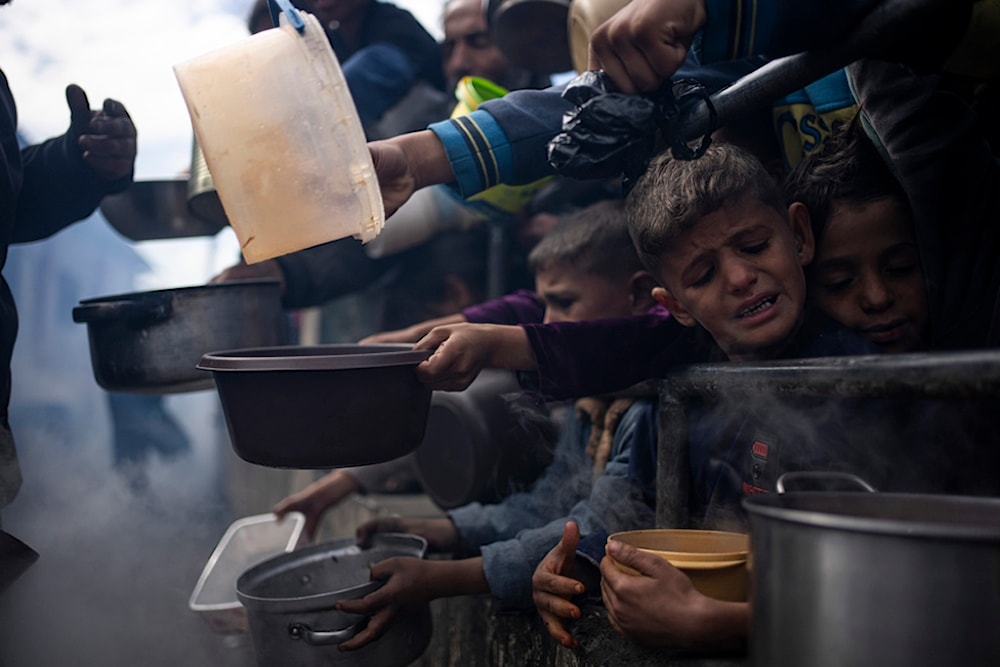1.1 billion people, 500 million+ children live in acute poverty: UNDP
The report, led by the UNDP, reveals that almost half of those impacted by poverty live in warring countries and conflict zones.
-

Palestinian children line up for a free meal in Rafah, Gaza Strip, Friday, Feb. 16, 2024. (AP)
Over a billion people are living in acute poverty across the globe, with more than half of those impacted being children, a United Nations Development Program report published on Thursday revealed.
The report was a collaboration between the UNDP, Oxford Poverty, and Human Development Initiative (OPHI), and affirmed that poverty rates were three times higher in war-ridden countries, given that in 2023, the world has seen the most conflicts and wars since World War II.
The methodology of the report is similar to those released since 2010 by the UNDP and OPHI, which examine data from 112 countries with a collective population of 6.3 billion people. Factors of study include the lack of adequate housing, sanitation, electricity, cooking fuel, nutrition and school attendance.
Yanchun Zhang, the chief statistician at the UNDP, commented on the results of the paper, saying, "The 2024 MPI paints a sobering picture: 1.1 billion people endure multidimensional poverty, of which 455 million live in the shadow of conflict."
Speaking to AFP, Zhang added that poor communities in war-affected countries make the struggle for basic needs "a far harsher and more desperate battle."
According to the findings, 584 million children are suffering of acute poverty, accounting to 27.9% children globally, compared to 13.5% of adults. The report further found that poverty rates are substantially centered in Sub Saharan Africa and South Asia, making for 83.2% of the world's poorest people.
Sabina Alkire, the director of the OPHI, also told AFP that conflicts obstruct efforts for poverty reduction, saying, "At some level, these findings are intuitive. But what shocked us was the sheer magnitude of people who are struggling to live a decent life and at the same time fearing for their safety –- 455 million."
"This points to a stark but unavoidable challenge to the international community to both zero in on poverty reduction and foster peace, so that any ensuing peace actually endures," Alkire added.
India had the highest number of people living in extreme poverty, affecting 234 million of its 1.4 billion population. Following India were Pakistan, Ethiopia, Nigeria, and the Democratic Republic of the Congo. Together, these five nations represented nearly half of the 1.1 billion individuals living in poverty globally.
The horrific case of Gaza
The implications of poverty include malnourishment, malnutrition, and starvation, which take a particular toll on children.
As the genocide continues in Gaza, a Washington Post report on Monday detailed the worsening humanitarian crisis in northern Gaza, as the Israeli Occupation Forces (IOF) intensify their aggression on the Strip.
The report shed light on the emerging strategy reportedly being employed by "Israel", described as a "surrender or starve" approach, which has drawn international condemnation.
The IOF have encircled the Jabalia refugee camp and issued evacuation orders to approximately 400,000 residents in northern Gaza, directing them South to already overcrowded and bombarded areas.
While the Israeli occupation government has not officially confirmed adopting the strategy, reports indicate that parts of it are being implemented.
Humanitarian groups have raised concerns over the tactic, with Doctors Without Borders warning that thousands of people are trapped in the Jabalia camp, facing starvation and being targeted by IOF.
In September, UNICEF’s Director of Child Nutrition and Development, Victor Aguayo, stated, “We estimate that well over 50,000 children suffer from acute malnutrition and need lifesaving treatment, now.”
His comments follow warnings from the UN’s food agencies, FAO and WFP, which have called the situation in Gaza “one of the most severe food and nutrition crises in history.”
“It’s important to remember that nearly half of Gaza’s population who are suffering this devastation are children,” Aguayo emphasized.
Reflecting on his recent visit to Gaza, he said, “I saw how months of war on civilians and severe restrictions to humanitarian response have led to a collapse of the food, health, and protection systems, with catastrophic consequences for children’s nutrition.”
Aguayo noted that young children’s diets are “extremely poor", with “over 90 percent of them eating at best two types of food per day – day in, day out – for weeks and months in a context of toxic stress and lack of access to safe water and sanitation.”
He also warned that “the risk of famine and a large-scale severe nutrition crisis in Gaza is real,” adding, “There is only one way to prevent it: we need a ceasefire, immediately, and with a ceasefire, sustained and large-scale humanitarian access to the entire Gaza Strip.”
Read more: OMCT: Naval blockade contributes to the starvation of Yemenis

 5 Min Read
5 Min Read








